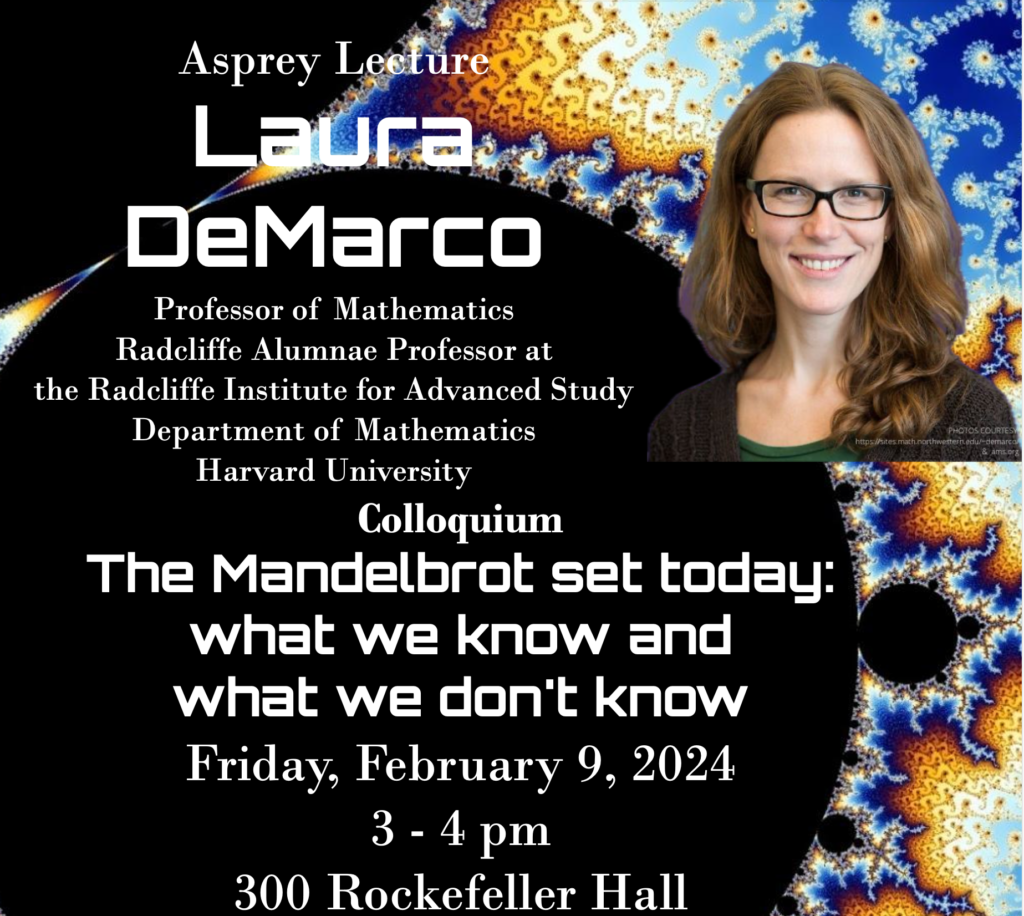The Asprey Distinguished Lecture Series is an annual series of lectures featuring the country’s most prominent mathematicians. The lecture series is in honor of Winifred Asprey, a Vassar graduate who taught mathematics and computer science at Vassar for 38 years before her retirement in 1982. Professor Asprey was one of the most admired members of the Vassar faculty and was nationally recognized as a spokesperson for mathematics and computer science. She founded Vassar’s Computer Center in the mid-60’s—one of the first such at a liberal arts college. She continued to live in the Poughkeepsie area until her death in 2007.

The Asprey Distinguished Lecture Series for 2025 will be given by Prof. Terence Tao (UCLA). Terence Tao was born in Adelaide, Australia in 1975. He completed his PhD under Elias Stein at Princeton in 1996 and has been a professor of mathematics at UCLA since 1999. Tao’s research spans harmonic analysis, PDE, combinatorics, and number theory. He has received many awards, including the Salem Prize in 2000, the Fields Medal in 2006, the MacArthur Fellowship in 2007, the Crafoord prize in 2012, and the Breakthrough Prize in Mathematics in 2015. Terence Tao holds the James and Carol Collins chair in mathematics at UCLA, and is a Fellow of the Royal Society, the Australian Academy of Sciences, the National Academy of Sciences, and the American Academy of Arts and Sciences. From 2020-2024, he served on the President’s Council of Advisors on Science and Technology.
Prof. Tao will give two talks this September, both open to the public. Both talks will be held in 300 Rockefeller Hall at Vassar College.
Machine Assisted Proof
September 11th, 2025 | 5pm
Abstract: For centuries, mathematicians have relied on computers to perform calculations, to suggest conjectures, and as components of mathematical proofs. In the light of more modern tools such as interactive theorem provers, machine learning algorithms, and generative AI, we are beginning to see machines used in more creative and substantive ways in our work. In this talk we survey some historical and recent developments, and speculate on the future roles of machine assistance in mathematics.
Recent Developments in Analytic Prime Number Theory
September 12th, 2025 | 3pm
Abstract: We survey some of the recent developments in the understanding of prime numbers in the last two decades, including rigorous results on small and large gaps between the primes; local Fourier uniformity (and higher order Fourier uniformity) on the primes; new zero density estimates; and tantalizing progress towards the Chowla conjecture, and possibly even the twin prime conjecture.
Past Asprey Lectures
- 1991–92: Stephen Smale, Chaos and the Godel Incompleteness Theorem
- 1992–93: William P. Thurston, An Introduction to the Geometry and Topology of Three-dimensional Manifolds
- 1993–94: Kenneth Ribet, Fermat’s Last Theorem
- 1994–95: John H. Conway, Shapes and Symmetries
- 1995–96: Joan Birman, Knots, Differential Equations, and Chaos
- 1996–97: Angus MacIntyre, What Can Logic Tell Us About the Real Exponential Function?
- 1997–98: Charles Fefferman, Atoms, Numbers, and Stars
- 1999–2000: Sir Michael Atiyah, Atoms, Knots, and Elementary Particles
- 2000–01: Vaughan Jones, Noncommutative Geometry for Dummies
- 2002–03: Peter Neumann, The Memoirs of Évariste Galois
- 2003–04: Hendrik Lenstra, Escher and the Droste Effect
- 2004–05: Jeff Weeks, The Shape of Space
- 2005–06: Ken Ono, Number Theory: Partitions and the Legacy of Dyson and Ramanujan
- 2006–07: Jon Kleinberg, Modeling the Web, Mining my E-mail, and Other Perspectives on the Information Revolution
- 2007–08: Avi Wigderson, A world view through the computational lens
- 2008–09: Margaret Wright, The Remarkable Saga of Linear Programming: the Problem, the Methods, the Continuing Mysteries
- 2009–10: Günter Ziegler, Proofs for THE BOOK
- 2010-2011: Trachette Jackson, Mathematical Biology: An Essential Part of 21st Century Science (postponed to Fall 2011)
- 2012-13: Martin Nowak, Evolution of cooperation
- 2013-14: Leila Schneps, Mathematics in the courtroom: uncharted territory
- 2014-15: Erik Demaine
- 2015-16: Don Saari, We vote, but do we elect whom we really should?
- 2016-17: W. Hugh Woodin, A short story of large infinities and small sets
- 2017-18: Maria Chudnovsky, Parties, doughnuts and coloring; some problems in graph theory
- 2018-19: Andrea Bertozzi, Mathematics of crime (delayed to Fall 2019)
- 2022-23: Eugenia Cheng, The joy of abstraction
- 2023-24: Laura DeMarco, From the solar system to the Mandelbrot set
2023-24 Asprey Lectures

Abstract: The field of dynamical systems has a long and fascinating history: it originated with the study of planetary motion and has become a central part of mathematics today, with many connections to algebra, geometry, and analysis. In this talk, I will present some of its historical development, with emphasis on the subtle question of linearization and how that leads to deep and difficult problems that remain unsolved today.

Abstract: One of the most famous–and still not fully understood–objects in mathematics is the Mandelbrot set. By definition, it is the set of complex numbers c for which the recursive sequence {c, c^2+c, (c^2+c)^2+c, …}, defined by x_1 = c and x_{n+1} = (x_n)^2+c, is bounded. But this set turns out to be rich and complicated and related to many different areas of mathematics. I will present an overview of what’s known and what’s not known about the Mandelbrot set, and I’ll describe recent work that (perhaps surprisingly) employs tools from arithmetic geometry to study these systems. The new work is a collaboration with Myrto Mavraki.
